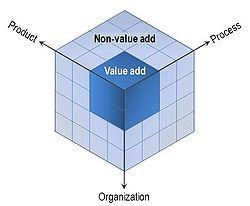A product rationalization project part of a portfolio optimization program
Product proliferation enables organization to serve customers´ varying requirements and needs as well as attracting new customers. By expanding the product portfolio organizations can capture new revenue sources and build and sustain a competitive advantage. Some organizations pursue the strategy of diversifying the product portfolio without fully understanding the extent to which implications can occur e.g. as new product variants are added complexity increases and higher costs are introduced in the supply chain.
When the portfolio consists of too many products, it becomes critical to the cost competitiveness of the organization to effectively manage and control the products in the portfolio. Through intelligent product rationalization by focusing on incremental revenue, incremental cost and a lifecycle perspective, it is possible to minimize revenue loss but ensure significant cost reductions, hence reducing complexity in the portfolio.[1] Additionally, prioritization and selection of products becomes essential to ensure alignment with the business strategy.
SKU rationalization is central to reduce complexity costs and thereby optimize and control the portfolio. Many companies have adopted complexity management approaches to reduce complexity costs and increase competitiveness. The aim of this article is to examine thoroughly the use of portfolio optimization in regards to SKU rationalization as a method to reduce complexity, control the portfolio and release resources. As a result, it is possible to maximize the strategic organizational goals by reinvesting in future projects to strengthen the portfolio while obeying budgetary restrictions.
Contents |
Background

The complexity cube framework describes how complexity develops from three interdependent dimensions. The ability to understand and identify from where complexity develops in the specific organizations increases the ability to analyze and remove it. The key takeaway from the complexity cube, see figure xx, is that the issues of complexity originates from the intersections between the dimensions and the costs associated with complexity is multiplicative between the dimensions, hence the effort to reduce complexity should be focused on multiple dimensions to create impact. The complexity costs grow exponentially with greater levels of complexity, hence organizations that can deliver good complexity and reduce or even eliminate bad complexity will create a sustainable competitive advantage. They will create an advantage because they will be significantly more profitable and the skills to manage complexity are difficult to replicate.[1]
Why product complexity arises
The need to regain control
How to regain control
How do you know if your have complexity?
ABC analysis
Incremental revenue Incremental cost A lifecycle perspective
SKU rationalization
Step 1
Step 2
Step 3
Step 4
Implications
How to fight complexity creep
Capability building Selection and decision models Other courses of complexity
==
Testing referencing.[3]
References
- ↑ 1.0 1.1 Wilson, A. S., & Perumal, A. (2010). Waging war on complexity costs. McGraw-Hill.
- ↑ Perumal, W. and Company (2013) How is complexity impacting your retail business? Available at: http://www.wilsonperumal.com/blog/how-is-complexity-impacting-your-retail-business/.
- ↑ Remember that all the texts will be included into the reference containing the name= attribute.